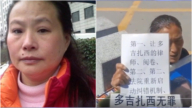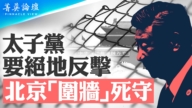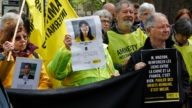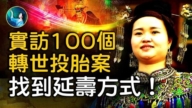【新唐人2012年1月27日讯】四川甘孜藏族自治州连续发生藏民与公安冲突事件,中共统战部官员把汉藏流血冲突原因指向达赖喇嘛。但研究西藏问题的学者指出,现在西藏的冲突与中共50年代的暴力镇压有关,与它们一贯的暴力行为有关,与达赖喇嘛无关。
英国BBC报导,过去一周,四川甘孜的炉霍县和色达县都相继发生军警与抗议藏民冲突事件。西藏流亡政府旗下“西藏之声”表示,6人被警察开枪枪杀,6名藏人受伤。中共喉舌《新华社》则声称:1名藏民死亡,5名警员受伤。
美国和英国都针对中共军警与藏民冲突事件表示了严重的关切。
不过,中共统战部官员朱维群把汉藏流血冲突归结于达赖喇嘛。他说“自从达赖喇嘛从政以来,他就不断使用暴力。”
西藏问题研究学者李江琳: “像朱维群他只是宣传部门的一个官僚,这些东西对信息封锁的国内民众有点用,在海外是根本没用的。哪有德国人相信他的话啊?”
在国外,达赖喇嘛是非暴力抵抗的象征。1998年,达赖喇嘛获诺贝尔和平奖,2007年他还获得美国最高荣誉奖——国会金质奖,都是因为他宣导非暴力政策,为争取西藏人权的贡献。
多次采访达赖喇嘛的李江琳表示,目前发生在四川的事件与2008年中共枪杀20多藏民有关,而2008年的藏民抗争又与1987年有关,追溯历史,都与50年代发生的战争有关,这也体现了中共一脉相承的暴力。
李江琳:“西藏从来不是我们现在说的和平解放,它是经过了一场秘密的战争。一场极端暴力的战争,长达6年半。其中,光是空军参战就是几千架次的飞机,它导致了非常深层的苦难。”
李江琳表示,发生冲突的地区,都是当年镇压非常残酷的地方。他指出,中共框架下的原则是宁左勿右,宁可错杀也不妥协,历史上中共对中国境内十几个民族,像对维族、彝族、回族、蒙族的镇压都是如此。
李江琳::“中共从50年代进入西藏以来,他有一个模式,就是他不接受任何挑战,不接受任何质疑,不接受任何建议。就是藏人反应出来的哪怕是温和的反对,都是用铁腕镇压。它50年代为什么这么做?他形成了一种可以说是:用更多的罪恶掩盖过去的罪恶。中国这么多年来,内地发生的事情也是这样,以10个错误掩盖一个错误。”
不过,这场中共军警与藏民的冲突还在发酵。一个西藏组织说,公安部队25号向群众开火,又导致两名藏民丧命。
美国国务院也表示:“中共政府处理西藏地区的适得其反的政策,导致西藏局势紧张,并威胁到西藏人民独特的宗教、文化以及语言认同。”
李江琳指出了冲突的内因是:中共的红头文件都表示“全党要为宗教消亡而奋斗”。所以,在中共信奉无神论、鄙视宗教的情况下,这场冲突不可避免。
新唐人记者陈汉、宋风 肖颜 采访报导
What Is The Real Cause Behind The Recent Tibetan Clashes?
Outbreaks of clashes between Tibetans and security forces
continue to emerge in Ganzi Tibetan Area, Sichuan province.
The Chinese Communist Party (CCP) has openly accused
the Dalai Lama of causing the Sino-Tibetan blood clashes.
A scholar in Tibetan history reveals however that the clashes’
root cause can be traced back to the Chinese regime’s brutal repressions of the 50’s.
and it’s consistent path of violence and has nothing to do with
The Dalai Lama who won the 1998 Nobel Peace Prize and a Congressional Gold Medal in 2007.
According to a BBC report, clashes between local Tibetans
and the police broke out last week in Ganzi, Sichuan province.
The Voice of Tibet reported six deaths and six injuries, but
according to the official Chinese Communist Party (CCP)
network, Xinhua News Agency,
apparently only one Tibetan
was found dead and five policemen were injured.
Meanwhile, the clashes have caused great concern over the
U.S. and in the U.K.
According to the deputy head of the CCP’s United Front Work
Department, the blood shed is attributed to The Dalai Lama.
Zhu Weiqun said: “Since The Dalai Lama entered into politics,
he has continued to use violence.”
To which Li Jianglin, an expert in Tibetan history, replied:
“Zhu Weiqun is merely a bureaucrat from the propaganda department.
Such a claim might make a little impact inside of China,
where there is no freedom of information,
yet it means nothing to overseas communities.
Is there any German who really believes in his words?”
The Dalai Lama is known worldwide as a symbol of
nonviolent resistance.
In 1998 The Dalai Lama won the Nobel Peace Prize and
in 2007 he received the U.S. highest civilian honor, a Congressional Gold Medal.
Both awards recognized him for his efforts in promoting
non-violence and his contributions towards better human rights in Tibet.
Li Jianglin interviewed The Dalai Lama many times. Li says
that the origin of the current Sichuan clashes have historic reasons.
According to Li the clashes are related to the killings
of 20 Tibetans in 2008.
Yet the 2008 protest can be traced back to the year 1987.
And all these events stem from the war of the 1950’s,
and the Chinese Communist Party’s consistent violence.
Li Jianglin, Scholar of Tibetan history: “Tibet has never been
peacefully liberated, an official claim that we’ve known so far.
The region has experienced a secret war,
one of extreme violence. It lasted six-and-a-half years.
The air force alone made a few thousand attacks,
which led to deeper problems.
Li Jianglin says the Chinese Communist Party waged very
cruel repressions in the conflict regions.
Apparently the CCP would rather kill wrongly
than to reach a compromise.
Mr. Li points out that in history, the Chinese Communist Party
has followed this principle during its crackdown on other
ethnic minorities such as the Uygur, Hui, Yi and
the Mongolians.
Li Jianglin, Scholar of Tibetan history: “Since the Chinese
Communist Party (CCP) entered into Tibet in the 1950’s,
it has set a pattern of non-acceptance. That is, of not
accepting any challenge, any questioning nor any proposals.
It has enforced an iron-fist repression on the Tibetans
even though it encountered mild opposition.
Why did it do it this way in the 50’s? It can be best described
as using more evil to cover up past wrongdoings.
It’s been happening in Mainland China also over so many years,
using ten errors to conceal one error.”
The clashes between Tibetans and the CCP police forces
are still ongoing.
According to a Tibetan group, security forces opened fire
on civilians on the 25th of Jan., killing two Tibetans.
The U.S. State Department says that the Chinese regime is
using “counterproductive policies”.
It is creating tension in the Tibetan Areas and is threatening
the religious, cultural and linguistic identity of the Tibetan people.
Li Jianglin discloses the clashes’ internal cause: As the CCP’s
official documents say, “the entire party fights for the religious demise."
Thus in the context of the CCP’s atheist belief and its
despising of religions, the clashes became inevitable.
NTD reporters Chen Han, Song Feng and Xiao Yan






















